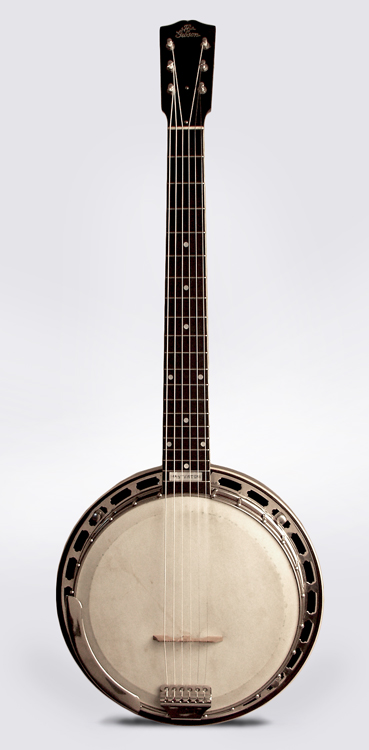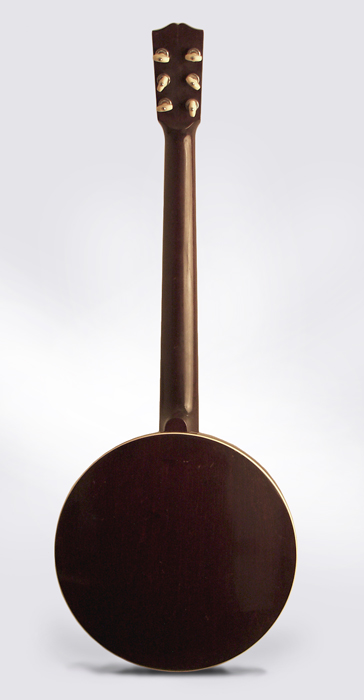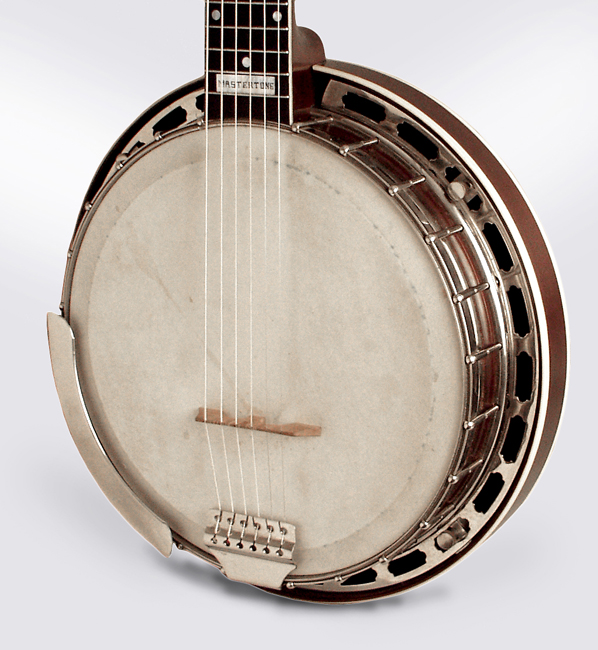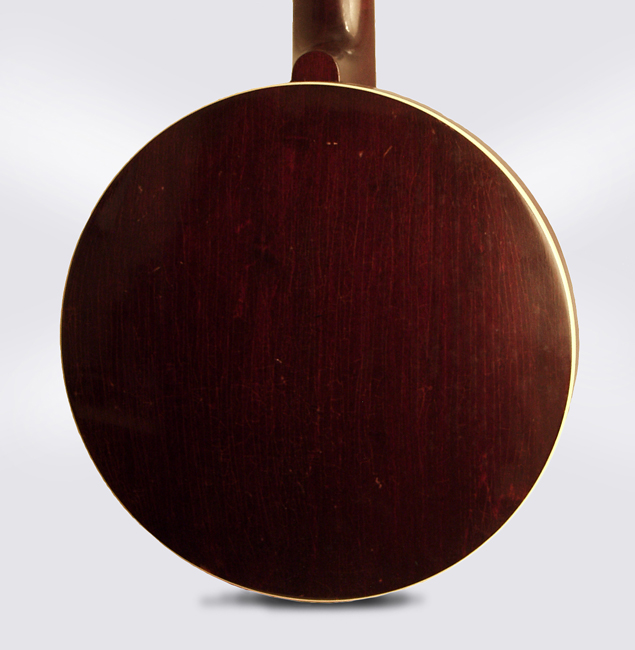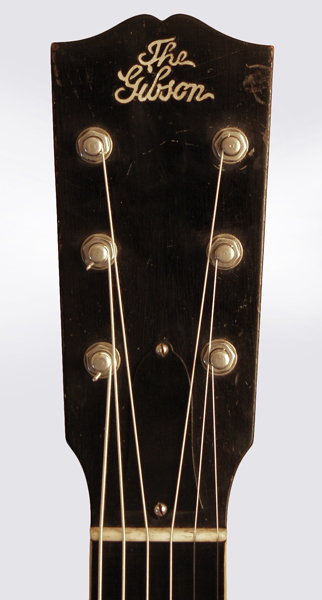Gibson GB-3 Mastertone Guitar Banjo (1928)
This item has been sold.
Item # 5415
Prices subject to change without notice.
Gibson GB-3 Mastertone Model Guitar Banjo (1928), made in Kalamazoo, Michigan, dark brown rim, natural neck finish, laminated maple rim; mahogany neck with rosewood fingerboard, original black hard shell case.
Here is a lovely example of one of the Gibson company's most elusive creations: a six-string Mastertone banjo. This is an extremely rare instrument, much more so than the company's earlier 'trap-door' style large-rim guitar banjos built prior to 1925. This one was made in 1928, one of a very few batches completed that year. The banjo is built on the standard 11" Mastertone rim (fully equivalent to the TB-3 from the same year) still with the older-style two-piece tube-and-plate flange but now equipped with the then-new 40-hole solid archtop tone ring. This is an important feature of this particular instrument as the earlier models have the less well regarded floating ball-bearing tone ring; the sound on this banjo is more focused with less overring and more snap.
The neck is a substantial round-backed affair with a bound dot inlaid ebony fingerboard and a guitar-shaped headstock with "The Gibson" inlaid in pearl script and six "Grover Patent" pancake tuners. Seminal early country fingerpicker Sam McGee used one of these GB-3's to back Uncle Dave Macon live and on disc in the 1920's and recorded several of his most famous pieces with it. In more recent times this model is most often associated with Neil Young, who has recorded some well-known songs on his and continues to feature it live. The Mastertone GB-3 is one of the coolest Gibson rarities and easily one of the best Banjo-guitars extant. This 1928 model is the first example with a solid tone ring we have had the pleasure of offering.
Overall length is 36 1/2 in. (92.7 cm.), 11 in. (27.9 cm.) diameter head, and 3 7/16 in. (8.7 cm.) in depth, measured at side of rim. Scale length is 25 1/2 in. (648 mm.). Width of nut is 1 3/4 in. (44 mm.). Very nice original condition; some very minor wear and typical checking but no repairs or alterations. The only hardware change is the two rim screws on the Kersher tailpiece. Still fitted with a nice period (likely original) Rodgers head (some dirt and staining but great sound) and bridge. A lovely example of an early Mastertone with the more sought-after 40-hole archtop (solid) tone ring, complete with the original HSC-which is also correct for a Plectrum or 5-string. Excellent Condition.
Here is a lovely example of one of the Gibson company's most elusive creations: a six-string Mastertone banjo. This is an extremely rare instrument, much more so than the company's earlier 'trap-door' style large-rim guitar banjos built prior to 1925. This one was made in 1928, one of a very few batches completed that year. The banjo is built on the standard 11" Mastertone rim (fully equivalent to the TB-3 from the same year) still with the older-style two-piece tube-and-plate flange but now equipped with the then-new 40-hole solid archtop tone ring. This is an important feature of this particular instrument as the earlier models have the less well regarded floating ball-bearing tone ring; the sound on this banjo is more focused with less overring and more snap.
The neck is a substantial round-backed affair with a bound dot inlaid ebony fingerboard and a guitar-shaped headstock with "The Gibson" inlaid in pearl script and six "Grover Patent" pancake tuners. Seminal early country fingerpicker Sam McGee used one of these GB-3's to back Uncle Dave Macon live and on disc in the 1920's and recorded several of his most famous pieces with it. In more recent times this model is most often associated with Neil Young, who has recorded some well-known songs on his and continues to feature it live. The Mastertone GB-3 is one of the coolest Gibson rarities and easily one of the best Banjo-guitars extant. This 1928 model is the first example with a solid tone ring we have had the pleasure of offering.
Overall length is 36 1/2 in. (92.7 cm.), 11 in. (27.9 cm.) diameter head, and 3 7/16 in. (8.7 cm.) in depth, measured at side of rim. Scale length is 25 1/2 in. (648 mm.). Width of nut is 1 3/4 in. (44 mm.). Very nice original condition; some very minor wear and typical checking but no repairs or alterations. The only hardware change is the two rim screws on the Kersher tailpiece. Still fitted with a nice period (likely original) Rodgers head (some dirt and staining but great sound) and bridge. A lovely example of an early Mastertone with the more sought-after 40-hole archtop (solid) tone ring, complete with the original HSC-which is also correct for a Plectrum or 5-string. Excellent Condition.
